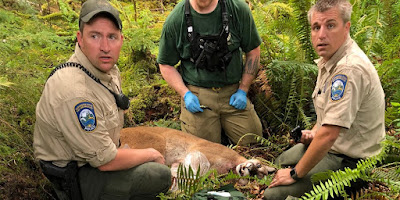Orcas in captivity... a comparison with Russia dissident Aleksei Navalny
 |
| Two mammal-eating "transient" killer whales photographed off the south side of Unimak Island, eastern Aleutian Islands, Alaska. Photo by Robert Pitman (NOAA). |
It is easy to become discouraged when you first hear of the impact of whaling on our cetacean neighbors. In 2014, researchers estimated that, between 1900 and 1999, 2.9 million whales were killed by the whaling industry. This doesn't count the whales killed prior to 1900, before diesel engines and exploding harpoons. In terms of biomass, this may be the largest removal of wildlife in human history, surpassing the removal of American bison from the plains states. And this was a minimum estimate, as wounded animals not recovered were not included in this estimate.
 |
| Casks of whale oil. Photo courtesy: New Bedford Whaling Museum/ NPS. |
These complex, intelligent mammals were rendered into a variety of products for industry and vanity. And the estimate demonstrates the number of whales that our oceans could hold. Alas, almost all whale populations are far below their pre-exploitation numbers.
In a few weeks (March 15 2024), the Denver Museum of Nature and Science will open their Orcas: Our Shared Future exhibit. This got me thinking again about whales, orcas, and our relationship with them. I'm not a killer whale biologist, although I used to require my college students to read about them (Carl Safina's Beyond Words: What Animals Think and Feel). I've watched Blackfish and The Whale (the film about Luna). I've read Death at Seaworld and I'm just finishing Beneath the Surface by Sea World senior orca trainer John Hargrove. I got to watch J Pod on a trip out of Port Angeles, WA. And twice I had an undergraduate student who was completing an internship in the Puget Sound on orcas give a presentation to her fellow students. On a broader note, my students also watched and discussed the movie about dolphin capture, The Cove.
Then, I read this in the New York Times two days ago: "It was a system devised to break the human spirit, by making survival depend on total and unconditional obedience to the will of guards" (3 March, page 1). The article was about the Arctic prison (Penal Colony No. 3) where Russia dissident Aleksei Navalny lived and died. Read it again, substituting "orca" for "human".
"It was a system devised to break the orca spirit, by making survival depend on total and unconditional obedience to the will of guards."
This was a shock to think about. I had never thought of orcas in captivity, which I oppose, in these stark terms.
Reading about their life in captivity, and the physical confines and behavioral manipulation of captive orcas to do what the trainers/guards demanded, from being confined to an artificial pool environment a fraction of the size of the 90+ miles a DAY they could travel in the ocean, forced to live in solitary confinement (orcas are extraordinarily social animals) or with strange orcas who didn't even speak the same language, forced to accept the manipulation of their genitals (what would we call this for humans?) for artificial breeding to make more captive orcas... we developed a system to break the orca spirit.
 |
| "Corky II", a female orca performing at SeaWorld, San Diego, California, in 2009. "Corky II... is a female captive orca from the A5 Pod of northern resident orcas. At approximately the age of four, Corky was captured from Pender Harbour off the coast of British Columbia on December 11, 1969. She has lived at SeaWorld San Diego in San Diego, California since 1987. As of 2023, she is the oldest and longest kept captive orca. SeaWorld San Diego celebrates her birthday on 2 January every year" (from Wikipedia). |
Need more information about why marine mammals should not be kept in captivity? Check out the 6th edition of The Case Against Marine Mammals in Captivity, by the Animal Welfare Institute.
 |
| The size, coloration, and behavior of killer whales makes them an iconic species. Ironically, orca ecotypes don't breed with other ecotypes outside captivity, don't communicate, and often have different diets. How many species really are there? |



Comments
Post a Comment